Ride1UP Cafe Cruiser Review | Classic Design, Modern Performance
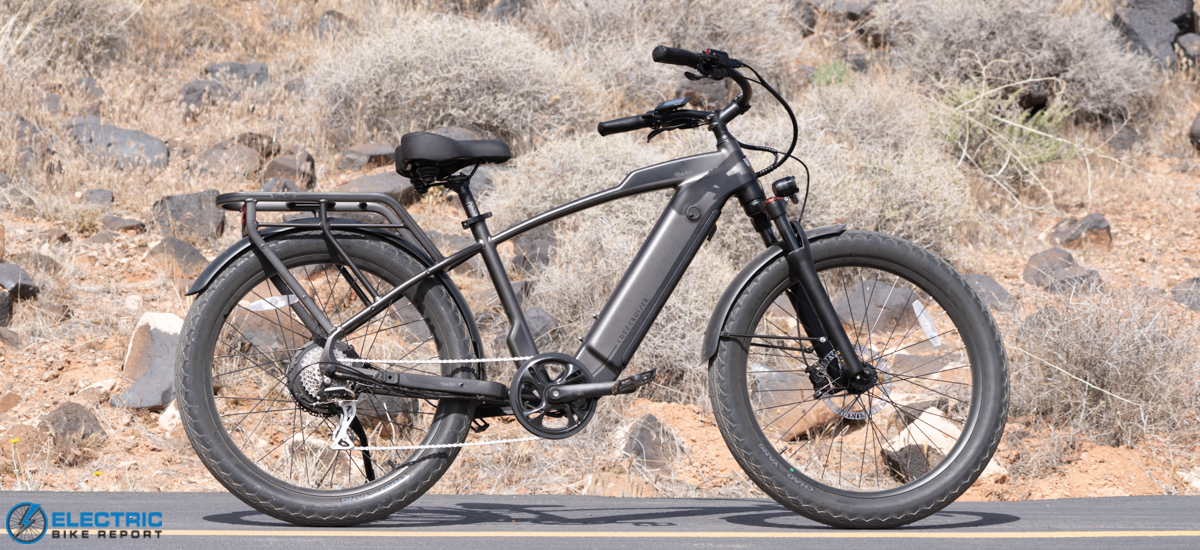
Electric cruiser bikes are as much about the looks as they are the ride, and the classic beach cruiser — a low-slung, laid back style of e-bike with swept bars and a broad seat — is a timeless look.
But a classic beach cruiser the Ride1UP Cafe Cruiser is not. It shares many of the same design elements, including the swept bars, extremely comfortable ride and a focus on aesthetics, but instead of drawing its inspiration from California beach culture, the Cafe Cruiser takes its cues from motorcycles.
In this Ride1UP Cafe Cruiser review, we put the bike through its paces in a series of real world tests designed to push the bike and its componentry to their functional limits. We test its hill climbing ability, its braking and even how far you can go on a single charge.
Built by a California-based e-bike brand with a focus on making really well done affordable e-bikes, the Cafe Cruiser boasts the looks and component package of a bike that costs several hundred dollars more. Its low price and good performance makes it an appealing choice for those on a tight budget or someone looking for a bargain.
Though our testing did reveal a small handful of performance tradeoffs you may not see on a more expensive e-bike, overall the Ride1UP Cafe Cruiser is an exemplary performing e-bike considering its price and intended use case.
 Pros
Pros- The old-fashioned motorcycle looks are really unique and done nicely. It’s not cosplaying as a motorcycle, rather it looks like an e-bike with a few small aesthetic easter eggs.
- The Shimano Acera 8-speed drivetrain is of equal quality to the groupsets we see on e-bikes that cost several hundred dollars more. It also features one more gear than we typically see in this price range.
- The welded rear rack can support up to 130 lbs of cargo and can even be fitted with a passenger seat and footpegs.
- The braking performance was stellar compared to other electric cruiser bikes we tested, stopping well above average.
- The 750W motor is very fast on flat ground, easily cruising near its Class 3 max motor assisted speed.
- The ride quality is very nice, with a geometry and riding position that’s right in line with what you’d expect from a comfortable cruiser.
 Cons
Cons- Without help from a rider’s legs, the 750W motor struggled on some of the steeper hills in our area. This is one of a very small number of 750W hub-driven e-bikes we’ve reviewed that did not clear our test hill on throttle power alone.
- Like many electric cruiser bikes, the Cafe Cruiser is large and sports a long wheelbase. Keep this in mind if riding in tight places.
- Battery: 48V, 15Ah (720Wh) frame-integrated battery
- Display: LCD Display
- Motor: 750W Bafang geared rear hub motor, 60Nm of torque
- Headlight: Buchel 80 Lux integrated light
- Taillights: Integrated
- Peal Assist: Five pedal assist levels, cadence sensor
- Range: 30-50 miles, claimed
- Throttle: Included
- UL Certification:UL 2271 Certified
- Claimed weight: 65 lbs
- Maximum rider weight: 300 lbs (total weight capacity)
- Maximum load on rear rack: 130 lbs
- Brakes: Zoom hydraulic disk brakes, 180mm rotors front and rear
- Fenders: Alloy fenders
- Fork: Mozo hydraulic fork, 80mm of travel
- Frame: Alloy
- Drivetrain: Shimano Acera 8-speed drivetrain
- Grips: Faux leather
- Saddle: Comfort saddle
- Handlebar: Swept alloy cruiser bars
- Kickstand: Included
- Pedals: Wellgo alloy pedals
- Tires: Chao Yang 26×3” tires
Ride1UP Cafe Cruiser Review: Bike Overview
Built around a 750W geared rear hub motor from Bafang and a 48V, 15Ah (720Wh) frame-integrated battery, the Ride1UP Cafe Cruiser is a Class 3 electric cruiser bike with a fairly unique styling.
In my opinion, it looks a little like the old World War II-era Harley Davidsons with its low-slung profile, swept bars and the frame’s gentle curvature from the head tube all the way down to the rear axle. Its aesthetic lives up to its name; the bike looks like it should be parked outside an old-timey cafe and ridden by a dude decked in leather and a flat-top biker cap. There’s even some frame accents that hint at a motorcycle-inspired design, such as a small bump in the forward part of the top tube that looks like a gas tank.
It’s sold stock as a Class 3 e-bike, meaning its 750W rear hub motor is capable of speeds near 28 mph while pedaling and up to 20 mph on the throttle, and that motor makes a descent 60 Nm of torque for acceleration and climbing hills.
It’s fitted with a classic cruiser bike’s low and long geometry that makes the bike stable and comfortable — though a little cumbersome and large in tight spaces — and it’s a generally pleasant ride.
Ride1UP is a company that specializes in making extremely affordable yet well appointed e-bikes, and the Cafe Cruiser’s spec sheet exactly fits their niche. At right around the $1,500 mark, the bike certainly is among the most affordable in the electric cruiser category, but it sports some componentry that’s notably nicer than many other similarly priced e-bikes.
The Cafe Cruiser’s drivetrain is full Shimano Acera 8-speed, a name-brand groupset with a reputation for reliability and solid performance. The brakes are hydraulic, which is notable considering many other e-bikes at this price use mechanical brakes, and it features a welded rear rack capable of hauling an impressive 130 lbs of cargo.
Rounding out the spec sheet is a utilitarian black and white LCD display and a Mozo hydraulic front fork with 80 mm of travel.
All-in-all, the Ride1UP Cafe Cruiser boasts an impressive parts list for being so affordable. And, with a handful of exceptions, it boasts a ride quality that feels more expensive than it is.

The Cafe Cruiser’s looks are a bit of a departure from the classic California beach vibes we normally see.
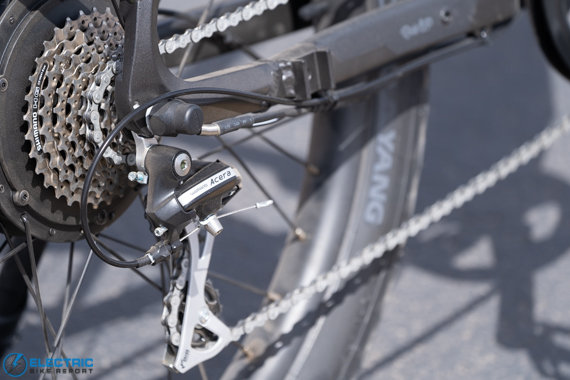
The Shimano Acera 8-speed drivetrain works great and is solid spec for the bike’s price.
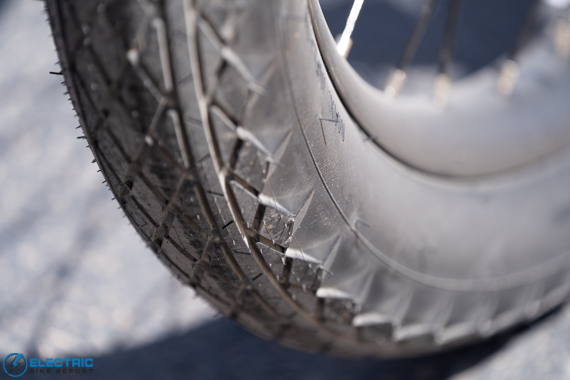
The Chao Yang tires have a little tread, but they’re going to work best on asphalt.
Ride1UP Cafe Cruiser Review: Motor Performance, Speed and Acceleration
On flat ground, the Cafe Cruiser’s Class 3 750W motor is notably fast. It accelerates quickly and holds speed very well, easily cruising near its max motor-assisted speed of 28 mph when in PAS 5.
That motor is controlled by a cadence sensor that’s better than average at detecting whether you’re pedaling or not. Motor engagement (and disengagement) happens very quickly, and the bike is quick on the throttle, too.
When using pedal assistance, the motor’s power is divided up into five power levels, with one being the least amount of power and five being the most. To get a sampling of how the bike performs in each PAS level, we put it to the test on our Electric Bike Report circuit starting with a lap with no help from the motor and going up from there.
What we found was a nicely divided power profile that gives very even and predictable jumps or reductions in power. This means that the rider will be able to carefully choose just how much assistance they’re getting from the bike by cycling through PAS levels.

The bike is stable in corners and its long wheelbase is confidence inspiring at high speed.

The 750W geared rear hub motor from Bafang makes 60Nm of torque.

The 48V, 15Ah (720Wh) battery is integrated nicely inside the frame.
Ride1UP Cafe Cruiser Review: Range Test & Battery Performance
The Ride1UP Cafe Cruiser comes stock with a 48V, 15Ah (720Wh) battery that’s integrated inside the downtube of the frame.
That’s slightly larger than the 672Wh batteries we see commonly specced on affordable e-bikes, especially among those that use the larger 750W hub motors. So does the Cafe Cruiser’s slightly larger battery give it a leg up in battery range?
To put it short, it does not appear to. At least not according to our real-world range testing.
We did two range tests on the Cafe Cruiser where we rode the bike from full charge to dead. The first was in PAS 2 and the second in PAS 5.
In the PAS 2 test, the Cafe Cruiser lasted 45.56 miles before dying and in PAS 5 it went for 26.23 miles. Compared to other Ride1UP e-bikes and other e-bikes we’ve tested in the cruiser category, that’s a fairly middle of the road result. It’s not a record-setting range, but it certainly is enough to handle anything you’d want to reasonably do with the bike.
So while the larger battery may not yield any larger-than-average range test results, it does give the bike a really nice range.
Ride1UP Cafe Cruiser Review: Hill Test
In our uphill testing we got a mixed bag of results from the Cafe Cruiser, but before I dive into the details, let’s make one thing clear: This is an electric cruiser bike, made for cruising bike paths, boardwalks and casually riding around town.
It’s not a thoroughbred hill climber, so it’s no surprise that our test hill Hell Hole gave the Cafe Cruiser some problems. Hell Hole, for context, is a one-third of a mile long section of bike path that pitches at an average gradient of 12 percent. That’s quite a bit steeper than the average hill, let alone the average hill in this bike’s natural habitat.
But enough of me couching the results, here’s how the bike did:
We conducted two timed tests of the Cafe Cruiser up Hell Hole. The first using just the throttle and the second in PAS 5.
It was in the throttle-only test that the bike had issues. Relying on the motor’s power alone, the Cafe Cruiser made it about one-third of the way before the motor cut out.
But in PAS 5, adding in just a nominal amount of effort using my legs, the bike cleared Hell Hole in a respectable 1:26.00 with an average speed of 12.6 mph.
It’s not at all uncommon that Hell Hole gets the best of an e-bike. In fact, the Cafe Cruiser is one of several just this month to struggle during the throttle-only test in particular. But what makes this incomplete more significant than normal is the fact that the Cafe Cruiser uses a 750W hub motor, a motor size that is almost always powerful enough to clear the hill.
But, as evidenced in the Cafe Cruiser’s result, motor wattage alone doesn’t tell a complete story of how well a motor performs — especially uphill. Torque is more important, and torque is exactly what the Cafe Cruiser lacks. Rated for just 60Nm of torque, the Cafe Cruiser’s motor is markedly less torquey than many 750W motors we test, which likely explains why it didn’t clear the hill on motor power alone.
That said, add in just a little additional torque through pedaling, and the Cafe Cruiser will likely clear most any reasonable (and paved) hill you put it against.
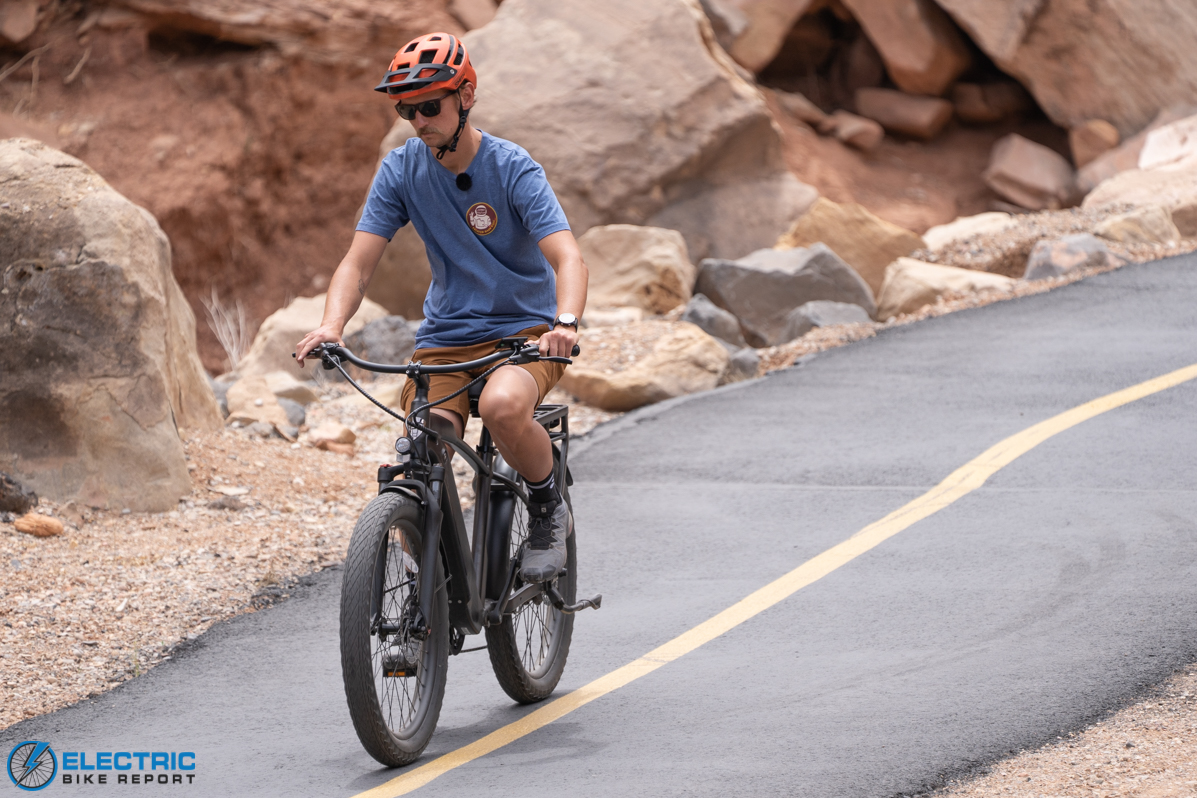
Climbing isn’t the Cafe Cruiser’s strongest suit, though I’d argue it’s not the strongest suit of any cruiser-style e-bikes.

The LCD display is functional and very easy to use.

Stopping is handled by a set of Zoom hydraulic disk brakes with 180mm rotors front and rear.
Ride1UP Cafe Cruiser Review: Brakes and the Brake Test
Ride1UP specs the Cafe Cruiser with a set of Zoom hydraulic disk brakes with 180mm rotors front and rear.
This is a budget-priced hydraulic brakeset we see often on bikes like this and that, according to our testing, often performs extremely well. The one caveat to this is we have had some reliability issues with the Zoom setup on several other e-bikes we’ve reviewed and it appears there is little — if any — official maintenance procedures from the manufacturer, so fixing them if you do have issues may be tricky.
But, fortunately for us, the Zoom brakes on the Cafe Cruiser worked exactly as they should.
In our brake test, where we bring the bike up to 20 mph five times and then slam on the brakes as hard as possible, the Cafe Cruiser came to a stop on average in 11-feet-8-inches. That’s several feet better than our current all-time average stopping distance of 15-feet-9-inches.
Reliability issues aside, the Zoom brakes have consistently proven capable in our testing and the set on the Cafe Cruiser were no different. Issues surrounding serviceability and reliability are also not unique to Zoom, and are issues we see really across the board when it comes to affordable hydraulic disk brakes. In Electric Bike Report’s experience, the affordable hydraulic disk brake rule typically works like this: If they are functioning properly, they typically stop well; if they’re not functioning properly or develop issues, you’re likely going to be replacing them instead of fixing them.
Ride1UP Cafe Cruiser Review: Ride Comfort, Handling and Cockpit
Most importantly, though, especially considering this is a very quick Class 3 e-bike, the Cafe Cruiser handles very nicely at high speed. Its long wheelbase makes it feel very stable and predictable in corners, though, conversely, it also makes it feel a little large and cumbersome in tight situations. U-turns on a bike path, for example, take a little extra planning to ensure they don’t turn into a three-point turn.
Its broad comfort saddle and swept handlebars really drive the Ride1UP’s cruiser styling home and give the bike a very comfortable upright riding position. There’s also an 80mm suspension fork from Mozo that really helps take the edge off road vibration and bumps.
Lastly, at the handlebars, Ride1UP specs the Cafe Cruiser with a fairly basic LCD display that does a great job displaying all your riding metrics such as speed, distance traveled, battery life, etc.

The welded rear rack can handle up to 130 lbs of cargo.

Like any good cruiser, the Cafe Cruiser’s saddle is broad and comfortable.
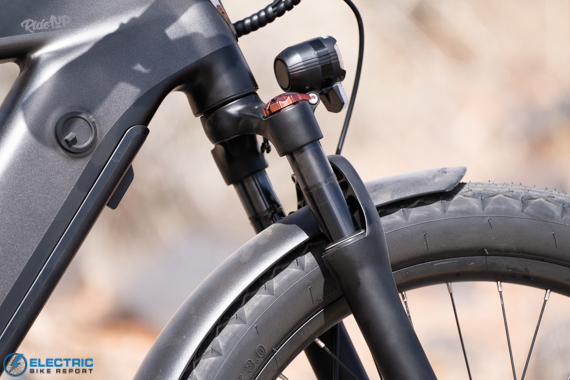
The Mozo suspension fork has just enough travel to smooth any bumps in the road.
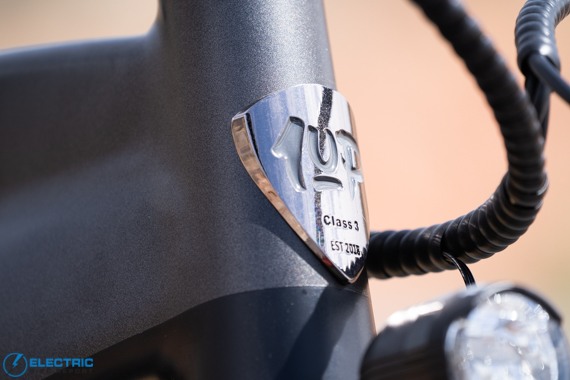
The Ride1UP logos on the Cafe Cruiser are very subtle, with the most overt branding being this chrome head badge.
Ride1UP Cafe Cruiser Review: Summary / Where to Buy
After all our testing and many, many hours spent on the bike, I still think the Ride1UP Cafe Cruiser’s looks are what stand out to me the most.
And that’s not to say this e-bikes performance or ride quality is sub-par to any extent, rather I’m really just enamored with how the bike looks. I’ve personally reviewed a laundry list of electric cruiser bikes and, by and large, they all really look the same; they’ve all got the same California beach culture-inspired looks, the same swept handlebars, broad seat and bright colorways. The Cafe Cruiser is the first I’ve reviewed in quite some time that broke the mold of what an electric cruiser bike can look like, and I really like what RIde1UP came up with.
On the performance side, the Cafe Cruiser did a solid job meeting most of my expectations. The componentry is great for the price, the motor is fast and the battery range is comparable with bikes that cost more. The only place the bike fell short was in its throttle-only hill test, but I have a hard time faulting the bike for that.
Again, this is a beach cruiser. It’s not designed to jet up ultra steep hills like Hell Hole, and I give it a lot of credit for how easily it handled the hill in PAS 5 when I added just a little help from my legs.
Between its unique looks, great price and solid performance, I’d definitely recommend the Ride1UP Cafe Cruiser for anyone who wants a comfortable ride that’ll stand out from the crowd. Like all of Ride1UP’s other e-bikes, the Cafe Cruiser can be bought online and shipped directly to your door.
Happy Riding, make sure to let us know if you have any questions down in our comments section or if you think we left anything out in this review of the Ride1UP Cafe Cruiser.




Hi Sam,
Good work! What a detailed review! Appreciate that!
Now I have a rough understanding of this bike although this brand is new to me.